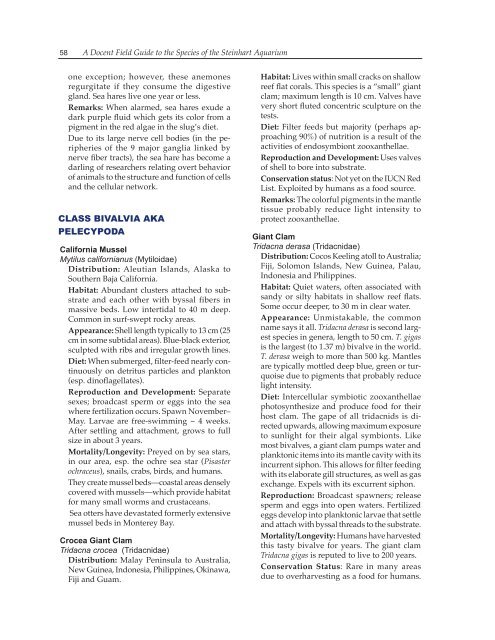THE STEINHART AQUARIUM - Gulf of Guinea Science ...
THE STEINHART AQUARIUM - Gulf of Guinea Science ...
THE STEINHART AQUARIUM - Gulf of Guinea Science ...
Create successful ePaper yourself
Turn your PDF publications into a flip-book with our unique Google optimized e-Paper software.
58 A Docent Field Guide to the Species <strong>of</strong> the Steinhart Aquarium<br />
one exception; however, these anemones<br />
regurgitate if they consume the digestive<br />
gland. Sea hares live one year or less.<br />
Remarks: When alarmed, sea hares exude a<br />
dark purple fluid which gets its color from a<br />
pigment in the red algae in the slug’s diet.<br />
Due to its large nerve cell bodies (in the peripheries<br />
<strong>of</strong> the 9 major ganglia linked by<br />
nerve fiber tracts), the sea hare has become a<br />
darling <strong>of</strong> researchers relating overt behavior<br />
<strong>of</strong> animals to the structure and function <strong>of</strong> cells<br />
and the cellular network.<br />
CLASS BIVALVIA AKA<br />
PELECYPODA<br />
California Mussel<br />
Mytilus californianus (Mytiloidae)<br />
Distribution: Aleutian Islands, Alaska to<br />
Southern Baja California.<br />
Habitat: Abundant clusters attached to substrate<br />
and each other with byssal fibers in<br />
massive beds. Low intertidal to 40 m deep.<br />
Common in surf-swept rocky areas.<br />
Appearance: Shell length typically to 13 cm (25<br />
cm in some subtidal areas). Blue-black exterior,<br />
sculpted with ribs and irregular growth lines.<br />
Diet: When submerged, filter-feed nearly continuously<br />
on detritus particles and plankton<br />
(esp. din<strong>of</strong>lagellates).<br />
Reproduction and Development: Separate<br />
sexes; broadcast sperm or eggs into the sea<br />
where fertilization occurs. Spawn November–<br />
May. Larvae are free-swimming ~ 4 weeks.<br />
After settling and attachment, grows to full<br />
size in about 3 years.<br />
Mortality/Longevity: Preyed on by sea stars,<br />
in our area, esp. the ochre sea star (Pisaster<br />
ochraceus), snails, crabs, birds, and humans.<br />
They create mussel beds—coastal areas densely<br />
covered with mussels—which provide habitat<br />
for many small worms and crustaceans.<br />
Sea otters have devastated formerly extensive<br />
mussel beds in Monterey Bay.<br />
Crocea Giant Clam<br />
Tridacna crocea (Tridacnidae)<br />
Distribution: Malay Peninsula to Australia,<br />
New <strong>Guinea</strong>, Indonesia, Philippines, Okinawa,<br />
Fiji and Guam.<br />
Habitat: Lives within small cracks on shallow<br />
reef flat corals. This species is a “small” giant<br />
clam; maximum length is 10 cm. Valves have<br />
very short fluted concentric sculpture on the<br />
tests.<br />
Diet: Filter feeds but majority (perhaps approaching<br />
90%) <strong>of</strong> nutrition is a result <strong>of</strong> the<br />
activities <strong>of</strong> endosymbiont zooxanthellae.<br />
Reproduction and Development: Uses valves<br />
<strong>of</strong> shell to bore into substrate.<br />
Conservation status: Not yet on the IUCN Red<br />
List. Exploited by humans as a food source.<br />
Remarks: The colorful pigments in the mantle<br />
tissue probably reduce light intensity to<br />
protect zooxanthellae.<br />
Giant Clam<br />
Tridacna derasa (Tridacnidae)<br />
Distribution: Cocos Keeling atoll to Australia;<br />
Fiji, Solomon Islands, New <strong>Guinea</strong>, Palau,<br />
Indonesia and Philippines.<br />
Habitat: Quiet waters, <strong>of</strong>ten associated with<br />
sandy or silty habitats in shallow reef flats.<br />
Some occur deeper, to 30 m in clear water.<br />
Appearance: Unmistakable, the common<br />
name says it all. Tridacna derasa is second largest<br />
species in genera, length to 50 cm. T. gigas<br />
is the largest (to 1.37 m) bivalve in the world.<br />
T. derasa weigh to more than 500 kg. Mantles<br />
are typically mottled deep blue, green or turquoise<br />
due to pigments that probably reduce<br />
light intensity.<br />
Diet: Intercellular symbiotic zooxanthellae<br />
photosynthesize and produce food for their<br />
host clam. The gape <strong>of</strong> all tridacnids is directed<br />
upwards, allowing maximum exposure<br />
to sunlight for their algal symbionts. Like<br />
most bivalves, a giant clam pumps water and<br />
planktonic items into its mantle cavity with its<br />
incurrent siphon. This allows for filter feeding<br />
with its elaborate gill structures, as well as gas<br />
exchange. Expels with its excurrent siphon.<br />
Reproduction: Broadcast spawners; release<br />
sperm and eggs into open waters. Fertilized<br />
eggs develop into planktonic larvae that settle<br />
and attach with byssal threads to the substrate.<br />
Mortality/Longevity: Humans have harvested<br />
this tasty bivalve for years. The giant clam<br />
Tridacna gigas is reputed to live to 200 years.<br />
Conservation Status: Rare in many areas<br />
due to overharvesting as a food for humans.


